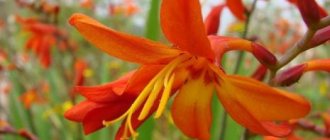Many gardeners are faced with a common problem: how to preserve successfully grown summer planting material of gladioli, begonias, montbretia, acidatera, zantedeschias, dahlias and other heat-loving plants stored until spring planting? The very first failure in storage sometimes forces the gardener to reconsider his attitude towards these beautiful plants and give up trying to grow them due to difficulties in storage. Let's try to figure it out: how to preserve summer-grown tubers, without loss if possible?
Storing dahlias
Before storing dahlia root tubers, they should not dry out too much, since when they overdry and wrinkle, they are stored worse, and in the spring they germinate poorly - however, insufficient drying of dahlias leads to rotting of the tubers during storage. To preserve dahlia root tubers, you must follow the following rules:
Preparing dahlias before storing
- The best storage mode for dahlia tubers is considered to be a temperature of 3...5°C and an air humidity of 60-70% with good ventilation;
- before storing, mechanically damaged tubers must be cleaned to healthy tissue and sprinkled with charcoal powder;
- dusting the tubers with chalk or ash before storing them in storage for the winter prevents rotting of the root collar - a place without which further storage simply does not make sense;
- Before storage, it is useful to dip hemp from dahlia stems in freshly slaked lime diluted in water until creamy;
- Before storage, washed and dried root tubers are dipped in a clay mash diluted to the consistency of sour cream, then dried again and after that placed in storage,
- Please note that it is not advisable to store potatoes or other vegetables next to dahlia tubers, which can cause the occurrence and spread of fungal diseases on the dahlia rhizomes;
- For storage, the treated tubers are placed on a layer of peat in boxes and sprinkled with peat. Instead of peat, you can use fresh sand or sawdust (also fresh, and preferably coniferous). When the tubers dry out and wither, the insulating material is slightly moistened;
- when stored in a city apartment, the tubers are stored in plastic bags with insulating material, which are placed in boxes and placed on the floor in the coolest place;
- good results when stored in warm and dry rooms are obtained by preliminary paraffinization (dipping clean and dry tubers into molten paraffin). Paraffinized root tubers are placed in bags filled with dry peat and tied tightly;
- During storage, tubers are regularly checked so that rotten specimens do not infect nearby ones;
- When signs of fungal diseases appear, rotten parts of the plants must be cut out, the tubers dried and pollinated with wood ash or dusted with Fundazol.
Gladiolus variety Snowy
Storing gladioli and acidanthera
Storing gladioli and acidanthera also has its own characteristics:
- The best place to store gladioli bulbs is a dry basement with a temperature of 3...9°C, but not lower than 2°C. A small number of bulbs can be stored on the bottom shelf of the refrigerator, intended for storing vegetables and fruits;
- Before storing, gladioli need to be dried, freed from children, roots and old bulbs. Insufficiently dried gladioli corms begin to hurt due to increased humidity under the scales, are poorly stored and die;
- Only thoroughly dried and healthy corms, without signs of disease, are stored for storage. All gladioli corms with signs of disease and cracked children are discarded;
- For storage, the bulbs are placed in cardboard boxes with holes for ventilation or hung in narrow mesh sleeves for vegetables. To prevent the spread of gladioli diseases, peeled garlic cloves, which have phytoncidal and antibacterial properties, can be placed in bags with planting material;
- minor damage to the bulbs can be cut out to healthy tissue and covered with brilliant green or treated with a strong solution of potassium permanganate;
Zantedeschia
- after digging, the plants are dried for several days, and then yellowed and wilted leaves are removed;
- Zantedes roots are carefully trimmed and dry soil is removed;
- Zantedes tubers are juicy and fragile, and if handled carelessly, they often break. Since the juicy pulp of the tuber is prone to rotting, the broken areas are treated with brilliant green, dried for 3-4 days, and only after that they are stored;
- Before storing the tubers, dry them for two weeks;
- Zantedes tubers are stored in slightly damp peat or dry sawdust.
- after digging, the above-ground part of the montbretia is cut off, leaving stumps 2-3 cm high;
- large nests of bulbs are not separated, washed, or shaken off the ground, but only dried, then placed in a container and completely covered with dry sand;
- containers (boxes) with montbretia are placed in a cool place and stored until spring;
- in March, the montbretia bulbs are removed, cleaned of soil and dead tissue, placed in a plastic bag, which is tied and kept in the light for germination;
- In early May, the sprouted plant bulbs are planted in the ground.
Storing montbretia:
Montbrecia can also be left to overwinter in a flower garden - securely covered bulbs can successfully overwinter directly in the ground. With the onset of stable negative temperatures (early November), montbretia plantings are mulched with a layer of peat or leaves (15-20 cm), and spruce branches or cut stems of perennial plants are placed on top of them, which press the leaf, preventing it from flying away from the wind, and trap snow.
If you doubt that your montbretia will successfully overwinter, arrange storage right in the garden. In a dry, elevated place, dig a groove 30-35 cm deep. Place plastic film on the bottom and pour wet sand. Place undivided montbretia nests on it in 2-3 layers. Fill the gaps thoroughly with sand. Wrap the film so that no water seeps inside. Cover the top of the storage with soil and insulate it with leaves or humus.
Storing tuberous begonia:
A gardener who is growing tuberous begonia for the first time should also be aware that small tubers of young begonias may dry out and disappear during winter storage. Therefore, young begonias are kept in a bright, cool place in winter, significantly limiting their watering. In this form, young begonias survive the winter - they do not lose stems and leaves, but practically do not grow.
Crocosmia, montbretia, tritonia are all names of the same flower, which gardeners also call Japanese or Chinese gladiolus. An unpretentious bulbous perennial plant came to Europeans from Africa.
That flower, which usually pleases the eye in flower beds, was bred through selective breeding by the Frenchman Lemoine. Montbrezia got its name from the name of a French botanist, and crocosmia is translated as “the smell of saffron.”
Montbrecia is an elegant plant with iris-like leaves and spikelets of funnel-shaped stars - flowers of white, yellow, brown, orange or bright red. The arrows of Japanese gladiolus flower growers can be tall and erect, and can smoothly bend between the leaves. The height of the flower spike is from 60 to 150 cm.
Montbrecia has gained popularity among gardeners due to its long flowering period, which can last from July to September, until the very first frost. Flowers look beautiful in bouquets and remain fresh when cut for up to two weeks.
The bulb of the Japanese gladiolus is small, covered with brown shells. Crocosmia fruits are round capsules with many seeds. You can grow and propagate this flower in your garden by planting corms, plants and seeds.
How are tubers and bulbs of ornamental flowering plants prepared for wintering and stored?
Montbretia, or crocosmia (Montbretia, Crocosmia)
This plant is usually treated like this: at the end of September, the corms are dug up, dried for several days at room temperature, and the corms are separated from the corms. Store at temperature +5. +7°С.
Another method will also work: dig up the bushes entirely, do not shake off the soil, and do not separate the baby. Store dried nests in an open container. If there are a lot of corms, then you can take a chance and leave some of them to overwinter in the soil, mulching with a thick layer of peat (at least 15 cm).
in the photo: flowering crocosmia or montbretia
How to store crocosmia in winter
Crocosmia, or Montbretia, is considered one of the most exquisite exotic garden decorations. Already in early spring, it attracts attention with its lush and long linear leaves, and in the summer you can’t take your eyes off the beauty. Crocosmia blooms in July with bright flowers in sunny shades that are fragrant with the aroma of saffron. The plant remains in its festive attire until the cold weather, which is why crocosmia is so popular in landscape design.
Tuberous begonia (Begonia x tuberhybrida)
The tuber of this plant must ripen in the middle zone. To speed up the process, from mid-August begonia flowers begin to be removed. Dig up the tubers before the start of morning frosts.
in the photo: flowering tuberous begonia, terry
They most often prepare for storage as follows: the stems are cut to 2–3 cm, the tubers are dug up with a scoop without clearing the roots of the soil, they are placed in boxes and transferred to a warm, well-ventilated room. After about two weeks, the remaining stems are removed, the tubers are cleared of soil and old roots and stored.
You can prepare the tubers differently: cut the stems, leaving 5–10 cm in length, wash the tubers, treat them with a fungicide and lay them out to dry. In dried tubers, the dried stems are easily separated. Storage conditions – temperature +6. +8°С, air humidity 80–85%. It is better to sprinkle the tubers with peat or sawdust.
in the photo: tubers of begonia clavaceae
Dahlia (Dahlia)
Dahlias are usually dug up at the end of September - October, when the bushes turn black after the first frost. Before digging, the stems are cut at a height of 8–12 cm from the root collar. When removing root tubers from the ground, try not to damage the renewal buds located at the root collar - without them the tubers will not germinate.
Dahlia nests are washed from the soil, carefully inspected, severely damaged tubers are cut out, thin feeding roots are removed and immersed for 30 minutes in a solution of potassium permanganate. Before storing them for 7–10 days, it is useful to keep them at low positive temperatures. During this time, the skin of the tubers will cork, preventing drying.
In storage, tubers are placed on shelves or in boxes. Optimal air humidity is 80%. In a dry room, the tubers dry out and wrinkle. If humidity is difficult to provide, then the dahlia are placed in boxes and sprinkled with sand, peat or sawdust. You can also protect them from drying out using a clay mash by dipping the tubers into it and drying them until a crust forms.
Storing dahlias
When to dig and how to store
It is very important not to rush in this matter - the better the corms ripen, the better they will be stored in the winter, so they need to be removed from the soil no earlier than the first ten days of October. The dug up dahlia tubers are carefully freed from the soil, washed under strong pressure of water, and then kept for a week in a room with high humidity and low but positive temperatures to cause the so-called suberization of the skin, which will protect the bulb from moisture loss during winter storage.
Then the bulbs are cleared of roots, their stems are cut off at a height of 3-4 cm from the neck, and the cut areas are treated with fluff lime. After this, each tuber should be placed in a paper bag, vermiculite should be added to it, the bag should be sealed or tied and stored at a temperature of 5-7 ºC, that is, in a basement or cellar that does not freeze in winter. Storage in the refrigerator is also possible, if there is room in it for dahlia tubers.
There is another storage method that protects dahlia planting material from drying out - treating the corms with paraffin before storage. To do this, paraffin is dissolved in a water bath to a liquid state and each bulb or baby is dipped into it. This should be done on an electric stove with a closed spiral, since paraffin is highly flammable.
A day before the procedure, bring the drying bulbs from a cool room to where the temperature is about 15 ºC, let them warm up, then dip each one in paraffin heated to 70-80 ºC and, after the paraffin has hardened, put the treated bulbs in a box and place to the coolest place in the apartment.
- Tulips - growing
Gladiolus, Tigridia, Acidanthera
These corms prepare for winter in the same way. At the beginning of October (if autumn is wet, then earlier, starting from the end of September), the stems are cut, leaving 15–20 cm in length. The plants are carefully removed from the ground so that the children do not fall off: they dig them up with a pitchfork and pull them out by the rest of the stem. After this, you can separate the baby.
Planting material is laid out by variety and size in pre-prepared containers. Under the young corm, the old, wrinkled corm is preserved; it is not yet separated so as not to damage the bottom. The corms and the baby are washed first in water, then in a solution of Intavir or Iskra and again in water, and then immersed in a solution of potassium permanganate. You can use the drug "Maxim".
in the photo: tigridia flower
After processing, the corms are laid out on newsprint and dried. The temperature is maintained at 25–30°C for 5–7 days, ensuring good ventilation of the room, then dried for a month at a temperature of +18. +20°C. If the old corm is easily separated, then the drying process can be considered complete. The dried remains of the stems are cut off with scissors. The covering scales are not removed.
Cardboard boxes or boxes with lids are used for storage. Their inner walls are treated from a spray can with an insecticide such as dichlorvos (any one intended for household purposes will do). Dried corms are laid out by variety in nylon bags and placed in boxes, covered with lids and wrapped in newsprint so that the insecticide evaporates more slowly. Optimal storage temperature is +1. +5°С, relative air humidity about 80%.
Reviews from flower growers
For flower growers in Eastern Europe, crocosmia has not yet become a familiar flower, due to the paucity of information and knowledge on how to care for it. But increasingly, Japanese gladiolus is becoming a bright decoration of garden areas, ridges, and alpine slides. Those who have hosted a European guest note the extraordinary beauty of group plantings, original bouquets, and the opportunity to use dry plants in room design.
Disadvantages include the poor cold resistance of some varieties and the need to dig them up for the winter.
—Categories
- ***MY. (122)
- My knitting (48)
- My kitchen (3)
- My sewing (9)
- My cat (Peach) (9)
- Videos, MK, tips, lessons (110)
- LiveInternet (80)
- LiRu-educational program (20)
- Mastering the computer (17)
- Diary design (15)
- Types of knitting (721)
- "Pineapple" (16)
- "Lily" (35)
- "Leaves" (44)
- Jacquard (15)
- Illusion knitting (6)
- Yoke, raglan (91)
- Braids, arans, plaits (117)
- Ribbon lace (16)
- Missoni(crochet) (42)
- Missoni(knitted) (13)
- Sirloin knitting (160)
- Sirloin knitting 2 (120)
- Types of knitting - “Motifs” (292)
- "African Flower" (16)
- "Granny Square" (38)
- Ideas (27)
- Models with descriptions (163)
- Motives+schemes (45)
- Knitting for adults (1639)
- Craftswomen with LiRu (31)
- Evening dresses (49)
- Knitting for men (115)
- Knitting+fabric (53)
- Hats (125)
- Designer models (57)
- Lace, border, collars (69)
- Mittens-socks-shoes (48)
- Blankets, pillows, rugs (162)
- Napkins-tablecloths-curtains (146)
- Bags (120)
- Decorations, flowers (103)
- Scarves, shawls, stoles, snoods (105)
- Japanese openwork (371)
- Knitting for children (660)
- . undisassembled. (69)
- for girls (174)
- for children under 1 year (58)
- for boys (134)
- magazines, websites (22)
- toys, etc. (5)
- ideas (10)
- shoes, etc. (59)
- blankets, etc. (54)
- hats, etc. (91)
- Knitting.Women's clothing (crochet) (204)
- Sleeveless vest, vest, etc. (12)
- Blouses, pullovers, etc. (65)
- Coats, cardigans, jackets (71)
- Dresses, suits, tunics (55)
- Knitting.Women's clothing (knitting needles) (762)
- Vest, bolero, sleeveless vest (63)
- Blouse, pullover, sweater (417)
- Coats, cardigans, jackets (158)
- Dresses, suits, tunics (122)
- Knitting. Summer is coming! (848)
- Boleros, jackets (122)
- Set (10)
- Blouses, tops (260)
- Men (6)
- dresses, sundresses (185)
- beachwear (37)
- tunics (133)
- Hats, umbrellas (30)
- skirts (62)
- Knitting.Knitting tips (409)
- types of yarn (13)
- MK hook (65)
- master classes (well, a lot. ) (31)
- MK knitting needles (160)
- crochet patterns (60)
- knitting patterns (78)
- For the soul. (126)
- A. Celentano. ))) (12)
- Vera (21)
- All for the party! (9)
- Birthdays-weddings-anniversaries (15)
- Let's relax! (2)
- Parables, stories, poems (16)
- Everyone watch. (7)
- This is interesting! (19)
- House-garden-vegetable garden (928)
- *** (2)
- all about indoor plants (71)
- we protect and fertilize. (144)
- interior (3)
- landscape design (52)
- vegetables:eggplant (9)
- vegetables: cucumbers (67)
- vegetables: pepper (9)
- vegetables:various (27)
- vegetables: tomatoes (62)
- vegetables:garlic (10)
- vegetable garden on the windowsill (20)
- useful tips (82)
- natural farming (68)
- vegetable seedlings (24)
- flower seedlings (9)
- garden flowers (49)
- fruits: apricot, peach (6)
- fruits: quince, etc. (3)
- fruits: cherry plum, plum (3)
- fruit:cherry (12)
- fruits: apple, pear (26)
- conifers, shrubs (12)
- bulbous flowers (1)
- perennial flowers (26)
- annual flowers (21)
- flowers - petunias, calibrachoa (16)
- rose flowers (37)
- eustoma flowers (1)
- berry:grape (26)
- berry: honeysuckle, etc. (7)
- berry:strawberry-strawberry (52)
- berry: raspberry, blackberry (30)
- berry: currant, gooseberry (7)
- Magazines and books on needlework (244)
- Asian magazines-1 (48)
- Asian magazines-2 (42)
- Knitting is your hobby (2)
- Fashion Magazine(1) (50)
- Fashion Magazine(2) (13)
- Handicraft books (6)
- Miscellaneous. (thirty)
- Sabrina (3)
- Health (717)
- . Let's exercise! (100)
- Children's health (14)
- Time-tested medicines (43)
- medicinal plants (54)
- we are being treated. (103)
- we bring beauty. ))) (190)
- healthy products (126)
- useful tips (80)
- We're losing weight. (29)
- Cooking (1307)
- Albums and magazines on cooking (4)
- Pancakes, donuts, bread, etc. (33)
- Oriental sweets (5)
- hot dish (66)
- cook from cereals (4)
- dessert, cookies (179)
- preparations for the winter (jam, etc.) (10)
- preparations for the winter (marinades, etc.) (66)
- preparations for the winter (salads, etc.) (86)
- preparations for the winter (sauces, etc.) (50)
- Korean cuisine (20)
- cooking tips (36)
- Easter cakes, cupcakes, etc. (29)
- Chicken dish (33)
- Meat dish (13)
- hastily. (113)
- drinks (11)
- Dumplings, manti, dumplings, etc. (10)
- Pies, pies (96)
- Pizza, Ossetian pies, placinda, etc. (29)
- Festive table (73)
- Recipes from Stalik Khankishiev (4)
- Fish dish (8)
- salads (96)
- Samsa, pasties, khachapuri, etc. (57)
- Sauces, seasonings, cheeses (29)
- Cake, pastries (132)
- cold appetizers (meat) (59)
- cold snacks (vegetables) (33)
- cold appetizers (fish) (52)
- Crazy hands ))) (3)
- Useful sites (10)
- Useful tips (120)
- Online stores (4)
- clean house (90)
- Thrifty housewife (16)
- Child development (5)
- Handicrafts (38)
- Handmade (136)
- decoupage (2)
- toys (30)
- gift ideas (29)
- various techniques (11)
- flowers made of fabric, leather, ribbons (21)
- Film library (15)
- Cinema (4)
- Cartoons (9)
- TV series (1)
- Television (4)
- Sewing is beautiful and easy! (400)
- Boho style (119)
- Evening dresses (15)
- Patterns, modeling and MK (172)
- Children (29)
- For home (16)
- The art of dressing well (29)
- Essential tips (13)
- Rework (17)
- Bags (26)
- Curtains (103)
- Video MK (7)
- Patterns, patterns (21)
- Curtain decor (10)
- The beauty of windows (17)
- Master classes (43)
- Sites, links (7)
—Quote book
Free description of the hat from https://www.instagram.com/natasha_knits/ General data: Ѐ.
10-MINUTES YEAST DOUGH “AIR EXPRESS” (VERY FAST AND FANTASTICALLY TASTY) Quote.
Pullover with openwork paths from Inna Tishchenko. Knitting needles. Source: Zhurna.
Cobblestone Pullover by Jared Flood
Motivi all'Uncinetto No. 46 2021 Publisher: Sprea SPA Language: Italian Italian magazine.
—Applications
- Postcards
Reborn catalog of postcards for all occasions - Cheap flights
Favorable prices, easy search, no commission, 24 hours. Book now - pay later! - I am a photographer
Plugin for publishing photos in the user's diary. Minimum system requirements: Internet Explorer 6, Fire Fox 1.5, Opera 9.5, Safari 3.1.1 with JavaScript enabled. Maybe it will work - Rating buttons "Yandex.blogs"
Adds Yandex rating buttons to the profile. Plus, graphs of rating changes per month will appear soon - Online game "Empire"
Transform your small castle into a mighty fortress and become the ruler of the greatest kingdom in the game Goodgame Empire. Build your own empire, expand it and defend it from other players. B
-Video
-Always at hand
—Search by diary
—Subscription by e-mail
Friday, February 17, 2021 22:02 + to quote book
Freesia
These tender plants are best grown in containers. They bloom in autumn. To ensure flowering lasts longer, containers with flowers are brought indoors at the end of September. Such a simple solution will allow the corms to ripen properly (this is unattainable outdoors in the middle zone).
After the above-ground part dies, the corms are dug up, washed, disinfected and slightly dried. Recommended storage temperature +26. +30°С. Freesia corms are small and very easy to dry out. Therefore, it is best to put them in sterile, tightly closed jars and place them near heating radiators or pipes. There are other recommendations, but we must honestly admit that not a single method of indoor storage guarantees high-quality flowering.
in the photo: freesia blooming
Crown anemone (Anemone coronaria), Asian buttercup (Ranunculus asiaticus)
After digging, the thickened rhizomes of these plants are washed, treated in a fungicide solution and dried to the state of “crackers”. Store in any box or bag at room temperature. Before planting, soak for a day.
In nature, this beautiful plant grows in southern Africa. In Europe, Crocosmia has been cultivated since the 19th century. Today this flower is widely popular among gardeners as a perennial bulbous plant. Crocosmia is also called Montbretia or Japanese gladiolus. The plant looks great in open flower beds. Designers recommend planting Japanese gladiolus with daylily, rudbeckia, and salvia.
Crocosmia has dense greenery, over which erect or drooping flowers bloom. The name of this plant translates as “saffron scent”, which is exactly the smell emitted by dried Montbretia flowers. This plant will be a worthy decoration of any garden, and cut inflorescences can delight with their beauty for fourteen days.
Where is the best place to plant Montbrecia?
Crocosmia is also called Japanese hyacinth, although it does not come from the Land of the Rising Sun, but from South Africa. It belongs to the iris family and is directly related to saffron, it even smells like it. This bulbous plant grows up to 1.5 m in height and blooms in yellow, red and orange. Japanese hyacinth is not an overly capricious flower, but it is still worth knowing some of the nuances of caring for it. Therefore, flower growers need to carefully choose a place where crocosmia would feel good.
Planting and care require choosing a sunny area, because the plant comes from the south. Crocosmia needs sunlight to form buds; in the shade it may not bloom. Montbrecia feels great on any soil. The plant tolerates drought, but still loves to be watered regularly, without allowing water to stagnate. The site for planting a flower should be prepared in advance in the fall, and the bulbs are planted in April or May, when it gets warmer.
Description of the plant
Montbrecia is a herbaceous perennial. The height of the plant can be from 60 cm to 150 cm. The rhizomes of the plant are many corms that grow in large clusters. Each tuber is covered with several shells. Crocosmia leaves are narrow, sword-shaped and light to deep green in color. The peduncles are thin, branched and reach up to 1 meter in length.
Crocosmia blooms from June to September. The flowers are star-shaped, about 5 cm in diameter, collected in a long panicle. The buds bloom alternately, starting from the base. In the southern regions of our country, the seeds of this plant have time to ripen.
How to grow from seeds
If you sow seeds in open ground, there is a high probability that they will not germinate. Planting of crocosmia begins in late February or early March. The seeds of the plant are soaked for 48 hours in warm water, and the water is changed every 6 hours. Light, fertile soil is suitable for germinating motbrecia.
It is good if the soil mixture includes turf soil, sand, peat, and humus. The seeds are deepened and sprinkled with soil. The crops are watered and covered with film. Place the container with the planted seeds on a windowsill or other bright place. The film is removed once a day for 15-20 minutes; this helps evaporate excess moisture and is a good prevention of fungal infections.
After emergence of seedlings, watering is reduced. Now moisture is needed only after the top layer of soil has dried. When several true leaves appear on the plants, they are transplanted into separate containers.
Transplantation into open ground
Motbrecia is transplanted into open ground in early May. For this plant you need to choose an open, sunny place, located away from the passage of groundwater. The soil must be nutritious. If the soil is depleted, then in the fall two buckets of humus, 100 grams, are added per 1 m². slaked lime, 40 gr. superphosphate and 20 gr. potassium chloride.
Young plants are planted in shallow holes (3-4 cm) at a distance of 10-15 cm from each other. Leave 30 cm between rows. Planted plants are protected from the scorching sun and wind. After a few days, the shelter is removed. Plants grown from seeds bloom in the third year. Under the most favorable conditions, flowers can be seen in the second season.
Montbrecia (crocosmia): cultivation, planting and care
Montbrecia (croxmia vulgaris) is an excellent ornamental plant for the summer-autumn flower garden. Perennial, Iris family, native to South Africa. It can be planted separately or in groups with other flowers. The flower looks very impressive against the green background of the lawn. If you add a few sprigs of montbretia to the bouquet, it will become much more graceful.
Montbrecia is also popularly called “Japanese gladiolus”, because outwardly it resembles miniature gladioli. The plant has narrow leaves, the length of which reaches 40-60 cm, a narrow branched stem up to 100 cm high. 3-4 peduncles grow from a small corm. Paniculate inflorescences consist of small flowers of yellow or orange-red color. Montbrecia blooms long and profusely - from July to September.
Growing Montbrecia.
The plant is very light-loving and requires cultivation in open areas, otherwise there may not be flowering. Prefers moist, humus-rich soil. However, water should not stagnate. The soil for crocosmia is prepared in the fall. For 1 m2, 2 buckets of humus, 40 g of superphosphate, 20 g of potassium chloride, 100 g of slaked lime are required. In spring, nitrogen fertilizers are applied (30 g/m2).
Care. During the summer, after the appearance of the second leaf, once every 10 days they are fed with mineral fertilizers (2-3 g/l) or mullein infusion (1:10). During the formation of buds, fertilizing with potassium fertilizers (2 g/l) is added. Plants are watered abundantly once a week and the soil is periodically loosened.
Wintering. For the winter, montbrecia is covered with a layer of shavings or dry leaves at least 20 cm high, and a film is placed on top to protect it from dampness during thaws. A plant that has overwintered in the ground is usually more powerful, blooms earlier and blooms longer. But it is better to dig up varietal crocosmia for the winter.
Since the corms grow at the end of the season, they need to be dug up as late as possible, unless severe frosts have occurred, usually this is done at the end of October. The corms with the resulting baby are dug up in dry weather, the soil is shaken off and the stems are cut off, leaving 5 cm, then dried for several days. The prepared corms are placed in paper bags or boxes, sprinkled with dry peat, and left for storage in the cellar at a temperature of plus 5-7°C. In March, a month before planting, the montbretia is taken out of the cellar and kept at room temperature for several days, then prepared for planting.
Landing. The roots and remaining stems with leaves are cut off from the planting material, the “nests” are dismantled and the baby is separated, and the dry shells are cleaned. Before planting, the corm and baby are dipped for several hours in a warm 0.1% solution of potassium permanganate. In addition to the disinfecting effect, this allows you to accelerate the germination of planting material and the formation of roots.
Montbrecia, which overwinters in the ground, is dug up and divided once every three years.
Reproduction. Crocosmia reproduces by corms, seeds and offspring. Every year, one adult corm produces 5-6 children, which bloom within a year. Moreover, the mother bulb continues to bloom and multiply. When the soil warms up to 6-10 °C, you can start planting montbretia, usually at the end of April. Corms are planted to a depth of 6-8 cm, leaving 10-12 cm between plants, the baby is planted to a depth of 3-5 cm, with a distance of 5-6 cm between them.
Before planting in open ground, Montbrecia can be grown in a pot, and then planted in May-June. The babies are separated in the spring and later used for reproduction. Plants are also easily propagated by seeds. It is best to sow fresh, washed seeds. When sown in early spring indoors, flowers usually appear in the second year.
Having decided to grow “Japanese gladiolus”, you will be amazed by the grace and beauty of this flower and will become its constant adherent.
Candidate of agricultural sciences Sciences Ivanovich A.A.
Reproduction
Crocosmia reproduces by seeds and bulbs. A whole colony grows from one bulb. It is recommended to separate colonies every 3-5 years. This is done in early spring before planting. If this is not done, the crocosmia begins to bloom poorly.
Plants reproduce most quickly from small bulbs. If Montbrecia grows in a region with warm winters, then propagation by self-sowing is possible. To prevent this from happening, wilted flowers are cut off.
How to care for crocosmia?
Montbrecia is an unpretentious plant, but still, if you want the flower to live luxuriously and not exist, it is necessary to apply complex mineral fertilizers. Thanks to fertilizing, crocosmia will acquire a healthier appearance and increase budding. Planting and care require regular watering and weeding. In regions with a harsh climate, plant bulbs must be dug up, but in the southern regions they can be left in the ground for the winter. In this case, the crocosmia must be insulated and covered with fallen leaves. Having survived the first winter, the plant hardens and is no longer afraid of frost.
How to plant bulbs
A week before planting in open ground, the corms are brought into a warm room so that all biological processes are activated. Tubers are planted in early or mid-May. Bulbs are carefully examined; those that are broken or with obvious signs of disease are excluded.
To get rid of all kinds of infections, the tubers are placed in a slightly pink solution of potassium permanganate for half an hour. A large corm is divided into 3-4 parts. You can separate the children to eventually get young plants. The depth of planting corms is about 10 cm. The distance between them should be at least 15 cm. If the soil is insufficient, moistened, the plantings are watered.
Growing in a greenhouse
If the site has a solid greenhouse made of glass or polycarbonate, you can germinate corms in April. To do this, they are placed in boxes with soil and watered. Sprouts should appear soon. When the temperature reaches about +10 degrees (late April or early May), Crocosmia is planted in a permanent place.
Crocosmia is an undemanding plant. Montbrecia is watered approximately once every two weeks, but the plant can withstand temporary drought. Weeds are weeded out. If crocosmia is planted on poor soils, then fertilizers are applied once every 10 days. This can be a comprehensive fertilizer for flowering plants.
Crocosmia - garden decoration
Designers love working with montbretia. The plant looks great in mixed flower beds (mixborders); it is planted on the second or first row in large groups. Crocosmia is also very common in “dry”, “tropical” and gravel gardens. The photo of blooming Japanese hyacinth in combination with cannas, daylilies, dahlias, salvia, rudbeckia and other flowers enchants with its colors. Montbrecia is naturalized in natural gardens. The flower grows quickly, so its greenery can cover a large area in just a few years. Crocosmia can grow in the shade, although it is unlikely to bloom, but it will definitely decorate with its long green leaves. Montbrecia is also grown for cutting.
Pests and diseases
- Fusarium. With this disease, flower stalks become irregular in shape, leaves turn yellow and die, flowers change color and become deformed. Plants are sprayed with Benomil, and the bulbs are pickled in a Fludioxonil solution before planting.
- Gray rot. A fungal disease that covers the bulbs with a gray coating. This infection is easier to prevent than to cure.
- Jaundice. The plant dies from this virus. The tips of the leaves turn yellow first, and then the entire plant. The disease is spread by cicadas.
Among the pests that are partial to crocosmia are spider mites, thrips, and mole crickets. During prolonged drought, spider mites may appear; these small insects are almost invisible. However, they are dangerous because they drink plant sap and are carriers of infections.
Insectoacaricide preparations will help cope with spider mites. “Aktelik”, “Fitoverm”, “Karbofos” are used against thrips.
How to Preserve Corms in Winter
In southern regions with mild winters, crocosmia is not dug up, but must be covered with a thick layer (20-30 cm) of straw, fallen leaves, sawdust or spruce branches. A film is placed on top. In other cases, corms are dug up in October, before the onset of frost.
Before storing, the stem is cut off, leaving about 6 cm. The bulbs with children are laid out on burlap and dried in a dry, warm room for two to three days. A dry cellar or underground with a constant positive temperature of 4 to 6 degrees is suitable for storing bulbs. Tubers for storage are placed in boxes, sprinkled with dry sawdust and peat.
How to store crocosmia in winter at home
Nov 15 • Uncategorized • 57 Views • No comments on the post How to store crocosmia in winter at home
Contents
This spring I planted crocosmia bulbs for the first time, they bloomed very late, and with the first frost I brought a pot of blooming crocosmia into the house. After flowering, I cut off the dry leaves, but I don’t know where to store them in the winter - either in a cool room at home, or take them out to a greenhouse, mulch them with humus and cover them with snow. Help with advice.
Blooming crocosmia (and on the left in the flowerpot is acidanthera).
And this is trimmed and prepared for wintering.
Varieties
- “Babylon” – plant height 60 cm, deep orange flowers drooping;
- "George Davison" - distinguished by yellow flowers, plant height 70 cm;
- “Tangerine Queen” is a tall powerful plant up to 1.2 m, bright orange flowers;
- "Spitfire" - height 60 cm, flowering begins in August and ends in September. Flowers are orange;
- "Lucifer" - height 1.5 meters, erect peduncles with red flowers. Frost-resistant variety with mandatory shelter;
- Crocosmia paniculata. A tall plant up to 1.5 meters, it blooms early, the flowers are small orange. The seed box has a decorative appearance;
- Crocosmia Potsa - pastel pink flowers, the variety tolerates excess moisture. Height up to one meter.
The best varieties
The most common hybrid is Crocosmiflora. Emily McKenzie is also very popular; it is a late-flowering, highly decorative variety that grows up to 60 cm tall. Its flowers are erect, brownish with orange spots. “Star of the East” is a very beautiful orange-apricot crocosmia. The photo of this variety will not leave anyone indifferent. The flower is large, late blooming, resembles a star shape, grows up to 1 m in height. Such varieties as Norwich Canary, Solfatare, Walberton Red, Golden Fleece grow up to 60 cm. They bloom with red, apricot, lemon flowers.
Crocosmia Lucifer looks the most representative. It blooms with bright, erect, tomato-red flowers. It grows up to 1.5 m tall and boasts high frost resistance. Crocosmia Masoniorum has similar characteristics, only it blooms with bright orange flower stalks. The paniculate early-blooming montbrecia, which blooms with orange flowers as early as June, is extremely popular.
Crocosmia is a natural decoration of any garden and flower bed. More and more flower growers are paying attention to this beautiful plant, burning with bright colors. The number of crocosmia fans is constantly growing every year.
Reviews
Lyudmila, 39 years old : “Montbrecia has been growing on the site for several years, last year it divided the corms and bloomed well. During the summer I feed it twice with mineral fertilizer. The plant looks very beautiful and doesn’t require much care.”
Olga, 35 years old : “Crocosmia paniculata grows in our front garden, it begins to bloom early at the end of June, and pleases us with flowers until the frost. I store the tubers in the basement, where the temperature does not rise above + 8. Over the course of three years, the tubers have grown; this spring I plan to divide them into two parts. The flower is beautiful, passers-by always pay attention.”
Svetlana, 51 years old : “I purchased this amazing plant at a gardening fair. I knew practically nothing about it, but without special care the flowering was abundant, which greatly pleased our whole family. Our variety of crocosmia “Tangerine Queen”, a rather tall plant, has bright, orange flowers reminiscent of tangerines. We tried to cut it for a bouquet, but it stayed in the vase for more than a week.”
Care Tips
The Montbretia flower does not require special care. In summer it needs regular watering. It is important not to allow the soil to dry out.
Prolonged drought can destroy the plant.
Experienced gardeners recommend removing old leaves and inflorescences in a timely manner.
In this way, you can preserve the decorative effect of Japanese gladiolus for a long time.
Another interesting point is that the earlier the flowers are cut, the longer the bouquet will please the owners.
Watering, weeding and loosening
It is best to loosen the soil after watering and rain. Loose soil promotes better penetration of oxygen and moisture to the roots of the flower.
Both of these components are very important for the growth and development of Montbretia. Weed removal also cannot be ignored.
Weeds especially interfere with crocosmia at the initial stage of development. Weeds absorb micronutrients from the soil, leaving only a small amount for the flower.
Fertilizer application
For better growth and development, abundant flowering, Japanese gladioli are fed with mineral fertilizers. Do this 3 times.
It is recommended to alternate mineral fertilizing with the application of a solution of manure or bird droppings.
You can prepare the solution as follows:
- Bird droppings or manure are added to the bucket.
- Pour in water and stir thoroughly.
- They insist for several days. During this time, stir constantly.
Before watering, the prepared solution is diluted at a rate of 1:10 and watered over the crocosmia.
The first application of fertilizer is done when leaves appear. The second time is fed before flowering, the third time in the fall.
Garter to support
Some varieties of Montbrecia grow quite tall. It is recommended to tie them up. To do this, they stock up on pegs to which flower stalks are tied.
If this is not done, then under the weight of the inflorescences they may break off. A garter is also needed to ensure that nutrients reach the rhizomes.











